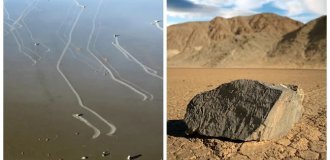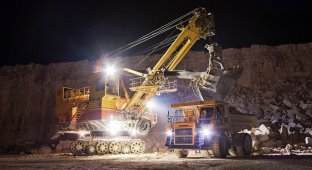How oil is extracted (13 photos)
LJ user Sergey Dolya writes: We were unlucky with oil. If in Iraq or Saudi Arabia it is enough to drill one shallow well in the sand, which is easy to drive up to in any SUV, then in our country the oil is concentrated in the Siberian swamps, where it is -50 in winter and +30 in summer and mosquitoes are the size of a good baby mammoth. It is impossible to drill in a swamp, so oil workers first cut down the forest, drain the swamp and fill out a sand area, the so-called “bush,” to which a road and electricity are connected. In order not to fill out such a site for each well, they are combined into groups of several dozen on one pad, and they are drilled not vertically down, but at an angle.

The bottom of the well (its bottom) can be located horizontally a couple of kilometers from the bush, and there are wells with a distance of 12 kilometers, for example, on Sakhalin. They are drilled at an angle because there is only one bush, and geologists need to cover a large area of the field with wells or, for example, they need to extract oil that is located under a city or nature reserve.
Different fields are drilled to different depths. In Western Siberia, the depth of the well is 1.5 - 2.5 km, in the Volga region it can reach 4.5 km, in Eastern Siberia about 2-3 km.
During the construction of a well, dozens of different services are involved: the “seismics” begin, then the “developers” come, then the drillers (who are divided into drilling fluid services, geophysical surveys, telemetry and bit service), then the well overhaul service, then the production department (Production workers They call themselves with the emphasis on O). They, in turn, are served by various “support platoons” - removal of sludge, special equipment, etc.
To carry out all this work, the Oil Company (OC) attracts numerous contractors. The same applies to filling bushes, roads, building dormitories for workers, and so on. NK itself owns the license for the field and is responsible for managing and financing all work performed by oil service companies. This is why oil companies have so many different subsidiaries.
P.S. I am sure that even girls will be interested in reading this post ![]()
(13 photos)

1. Drilling rigs (sorry about the oil) weighing about 1000 tons are used for drilling. At the top of the rig is a winch with a giant hook that moves a huge electric motor up and down. This design is called “top drive”.
The first to be lowered into the well is a bit (a blank with three spiked rotating ball heads), which directly drills. It is screwed onto weighted drill pipes (a linear meter of such a pipe with a diameter of 165 mm weighs 135 kg). In turn, weighted drill pipes are screwed onto ordinary drill pipes, which are pre-screwed into “candles” of 2-4 pieces together.
This whole sausage is called a “drill string” and is screwed to the shaft of a huge electric motor suspended on a giant hook.
When drilling a well, the “top drive” begins to rotate this entire sausage and goes down, transferring the weight of the string to the bit. A typical drill string in a well up to 3 km deep weighs 100-150 tons. This is a weight that hangs on a giant hook. Drill strings are lowered and raised many times due to the need to change the bit.
A special liquid – drilling mud – is pumped through the pipes under a pressure of about 50-150 atmospheres. The solution passes inside the entire sausage and exits through the bit, cooling it, after which it returns to the surface through the space between the walls of the column and the walls of the well, bringing cuttings (drilled rock) to the surface.
The solution is cleaned, and the sludge is thrown into a sludge pit (a hole that, after drilling is completed, is necessarily reclaimed, that is, covered with soil and grass is planted on it).
As necessary (danger of collapses, etc.), the well is strengthened with casing pipes, after which they continue to drill with a smaller bit. The well along its entire length is not the same in diameter: it starts with 393 mm, then 295 mm, then 215, and finally 143 mm.
Drilling a well takes from a month to a year, depending on many factors: length, geology, carelessness of the oil and drilling companies, etc.

2.

3. The so-called casing string is lowered into the finished well, and cement is pumped into the space between it and the well wall. This is done to prevent the collapse of the well walls.

4. Having drilled and cased the well, the drilling rig is transported on rails 5-7 meters to the side using hydraulic jacks and pushers to drill a new well. The well workover service (WRS) begins to work on the drilled well.
If you need to transport a drilling rig to another pad, it is disassembled into modules and transported in parts to a new location, where it is reassembled. In hard-to-reach areas where the deposit has not yet been developed, drilling rigs are assembled block by block using helicopters. The initial installation of a drilling rig usually lasts a little more than a month.

5. In order for oil to flow into a cemented well, a special charge is lowered into it, which shoots holes in the casing at the required depth. An electric pump is then lowered into the well, attached to tubing that carries oil to the surface.

6. This entire structure is crowned by ground-based equipment, called in Russian “fountain fixtures”, and in English called Christmas Tree. Oil is pumped directly by a centrifugal pump lowered to the bottom of the well, which supplies the pumped out liquid (it would be incorrect to call this emulsion oil) to various cleaning stations.

7. On a pad, wells are drilled in a row at an average distance of 5 meters from each other. Each well has its own “flow line”, through which the emulsion (oil + water) enters the AGZU - a metering unit, where the “flow rate” (the volume of produced products per day) is measured.

8. Metal structures above wells are cable racks.

9. But oil flows through these pipes. Many of our fields have a high degree of water cut, that is, only 30 percent of oil comes out of the well, and the rest is water. To prevent it from freezing in the pipes, they are wrapped in thermal insulation.

10. Wells are drilled by “drillers”, and oil is pumped from them by “oil and gas production operators”. The drillers live right on the pad in trailers, and the operators and everyone else live at the Field Support Base (FBS).

11. In the trailers of drillers there is always a drying room, a bathhouse and a dining room. The food is delicious, and even operators often stop by the drilling rigs to eat while touring their bushes. A set lunch costs about 100 rubles.
The work of drillers is very dangerous (high pressures in pipes during drilling, work under lifting mechanisms) and requires high concentration of attention. But the problem is that workers get tired, lose concentration, and therefore injuries often occur, and very serious ones (legs and arms are torn off, they lose sight, they die). This is a pressing issue in the industry.
They work at the drilling rig on a shift basis. The shift lasts from 2 weeks to a month. For hard labor, a driller's assistant receives about 80 thousand rubles a month. Then he rests for a month and receives nothing. The total is 40 thousand rubles per month.

12. At each field there is a so-called “torch”. It is needed to burn associated gas dissolved in oil. The gas factor is different at different fields: in some places there is a lot of gas, in others there is almost none.

13. People usually wonder why this gas isn’t sold to Gazprom? The answer is simple: cleaning associated gas and bringing it to Gazprom standards costs much more than the gas itself. It's easier and cheaper to burn it. However, since 2012, all oil producing companies have been obliged to increase the utilization of associated gas to 95%. That is, do not throw any slag into the atmosphere, but clean it up and sell it






















